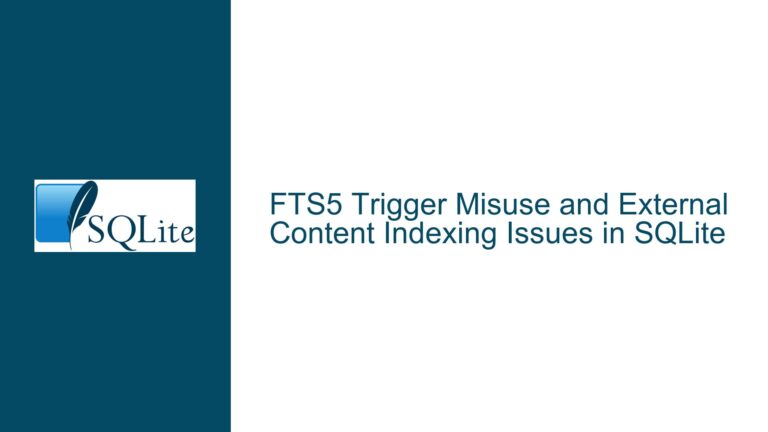Resolving UNIQUE Constraint Issues in SQLite Geopoly for Multi-Entity Locations
Understanding the UNIQUE Constraint Failure in Geopoly’s _shape Column
The core issue revolves around the inability to insert multiple records into a SQLite Geopoly table when these records share the same geographic location. This problem manifests as a SqliteError: UNIQUE constraint failed: materialCitationsGeopoly._shape, indicating that the _shape column, which is inherently tied to the Geopoly extension, enforces a UNIQUE constraint. This constraint prevents the insertion of multiple entities with identical geographic coordinates or shapes into the table.
Geopoly is a SQLite extension designed for handling geographic data, particularly polygons. It builds upon the Rtree extension but introduces additional functionality and constraints. One such constraint is the UNIQUE constraint on the _shape column, which is not present in Rtree. This constraint ensures that each geographic shape or location is uniquely represented in the table. However, this design choice becomes problematic when multiple entities need to be associated with the same location, as the UNIQUE constraint prevents such inserts.
The _shape column in Geopoly is typically used to store geometric data, such as polygons or points, that represent geographic locations. When inserting data into a Geopoly table, SQLite checks whether the _shape value already exists in the table. If it does, the insertion fails due to the UNIQUE constraint. This behavior contrasts with Rtree, which allows multiple entries with the same spatial coordinates, making it more flexible for certain use cases.
The challenge, therefore, is to find a way to store multiple entities at the same geographic location in a Geopoly table without violating the UNIQUE constraint on the _shape column. This requires a deep understanding of how Geopoly handles spatial data, the implications of the UNIQUE constraint, and potential workarounds or alternative approaches to achieve the desired outcome.
Exploring the Causes Behind the UNIQUE Constraint in Geopoly
The UNIQUE constraint on the _shape column in Geopoly is not arbitrary; it serves specific purposes related to data integrity and performance optimization. Understanding these underlying causes is crucial for devising effective solutions.
First, the UNIQUE constraint ensures data integrity by preventing duplicate entries for the same geographic shape. In many applications, such as mapping or geographic information systems (GIS), having multiple identical shapes or locations in a dataset can lead to ambiguity and errors. For example, if two polygons representing the same geographic region are inserted into the table, queries targeting that region might return inconsistent or duplicate results. The UNIQUE constraint mitigates this risk by enforcing a one-to-one relationship between geographic shapes and table entries.
Second, the constraint aids in performance optimization. Geopoly, like other spatial extensions, relies on efficient indexing and querying of spatial data. Allowing duplicate shapes could complicate indexing mechanisms, leading to slower query performance. By ensuring that each shape is unique, Geopoly can maintain a more efficient indexing structure, enabling faster spatial queries.
However, these benefits come at a cost. In scenarios where multiple entities need to be associated with the same geographic location, the UNIQUE constraint becomes a hindrance. For instance, in a database tracking material citations at specific locations, multiple citations might be associated with the same geographic coordinates. The current design of Geopoly does not accommodate such use cases out of the box, necessitating alternative approaches.
Another factor to consider is the relationship between Geopoly and Rtree. While Geopoly is built upon Rtree, it introduces additional constraints and functionalities. Rtree, which is primarily designed for spatial indexing, does not enforce a UNIQUE constraint on spatial data. This difference highlights the distinct design philosophies behind the two extensions: Rtree focuses on spatial indexing efficiency, while Geopoly emphasizes data integrity and unique representation of geographic shapes.
The interplay between these factors underscores the complexity of the issue. The UNIQUE constraint in Geopoly is a deliberate design choice with valid justifications, but it can pose challenges in specific use cases. Addressing these challenges requires a nuanced understanding of both the constraints and the underlying mechanisms of Geopoly.
Strategies for Inserting Multiple Entities at the Same Location in Geopoly
Resolving the issue of inserting multiple entities at the same location in a Geopoly table involves a combination of schema design adjustments, query modifications, and potential use of auxiliary tables. Below, we explore several strategies in detail, each tailored to different scenarios and requirements.
Schema Redesign: Introducing a Composite Primary Key
One approach is to modify the table schema to accommodate multiple entities at the same location. This can be achieved by introducing a composite primary key that includes both the _shape column and an additional identifier column. The additional column could represent a unique identifier for each entity, such as an auto-incrementing integer or a UUID.
For example, consider the following schema modification:
CREATE TABLE materialCitationsGeopoly (
entity_id INTEGER PRIMARY KEY AUTOINCREMENT,
_shape GEOPOLY,
citation_data TEXT,
UNIQUE(entity_id, _shape)
);
In this schema, the entity_id column serves as a unique identifier for each entity, while the _shape column continues to store the geographic shape. The composite primary key ensures that each combination of entity_id and _shape is unique, allowing multiple entities to share the same geographic location without violating the UNIQUE constraint.
This approach maintains the integrity of the geographic data while providing the flexibility to associate multiple entities with the same location. However, it requires careful management of the entity_id values to ensure uniqueness and may necessitate changes to existing queries and application logic.
Auxiliary Table for Entity-Location Mapping
Another strategy involves using an auxiliary table to map entities to geographic locations. This approach decouples the entity data from the geographic data, allowing multiple entities to reference the same location without duplicating the geographic information.
Consider the following schema design:
CREATE TABLE geographicLocations (
location_id INTEGER PRIMARY KEY AUTOINCREMENT,
_shape GEOPOLY UNIQUE
);
CREATE TABLE materialCitations (
citation_id INTEGER PRIMARY KEY AUTOINCREMENT,
location_id INTEGER,
citation_data TEXT,
FOREIGN KEY (location_id) REFERENCES geographicLocations(location_id)
);
In this design, the geographicLocations table stores unique geographic shapes, with each shape assigned a unique location_id. The materialCitations table stores entity data and references the corresponding location_id from the geographicLocations table. This approach allows multiple entities to reference the same geographic location by sharing the same location_id.
The advantage of this approach is that it maintains the UNIQUE constraint on the _shape column in the geographicLocations table while enabling multiple entities to be associated with the same location through the materialCitations table. However, it introduces additional complexity in querying and joining data across the two tables.
Leveraging Rtree for Spatial Indexing
Given that Rtree does not enforce a UNIQUE constraint on spatial data, another option is to use Rtree for spatial indexing while storing additional entity data in a separate table. This approach leverages the flexibility of Rtree for handling multiple entities at the same location while maintaining the integrity of the entity data.
Consider the following schema design:
CREATE VIRTUAL TABLE spatialIndex USING rtree(
id INTEGER PRIMARY KEY,
minX, maxX, minY, maxY
);
CREATE TABLE materialCitations (
citation_id INTEGER PRIMARY KEY AUTOINCREMENT,
spatial_id INTEGER,
citation_data TEXT,
FOREIGN KEY (spatial_id) REFERENCES spatialIndex(id)
);
In this design, the spatialIndex table uses Rtree to store spatial data, with each entry assigned a unique id. The materialCitations table stores entity data and references the corresponding spatial_id from the spatialIndex table. This approach allows multiple entities to reference the same spatial location by sharing the same spatial_id.
The advantage of this approach is that it leverages the flexibility of Rtree for spatial indexing while maintaining the integrity of the entity data. However, it requires careful management of the relationship between the spatialIndex and materialCitations tables and may necessitate changes to existing queries and application logic.
Custom Data Encoding for Unique Shapes
A more advanced strategy involves custom encoding of geographic shapes to ensure uniqueness while allowing multiple entities at the same location. This approach requires modifying the way geographic shapes are represented in the _shape column to include additional information that ensures uniqueness.
For example, consider encoding the entity identifier directly into the geographic shape data. This could involve appending the entity identifier to the coordinates of the geographic shape, effectively creating a unique shape for each entity even if they share the same geographic location.
CREATE TABLE materialCitationsGeopoly (
_shape GEOPOLY UNIQUE,
citation_data TEXT
);
-- Example of inserting a custom-encoded shape
INSERT INTO materialCitationsGeopoly (_shape, citation_data)
VALUES (GeopolyEncodeWithEntityId(shape_data, entity_id), citation_data);
In this approach, the GeopolyEncodeWithEntityId function would modify the geographic shape data to include the entity identifier, ensuring that each shape is unique even if the underlying geographic coordinates are the same. This approach requires custom encoding and decoding logic to be implemented in the application layer.
The advantage of this approach is that it maintains the UNIQUE constraint on the _shape column while allowing multiple entities to be associated with the same geographic location. However, it introduces additional complexity in encoding and decoding geographic shapes and may impact query performance.
Conclusion: Choosing the Right Strategy
Each of the strategies outlined above offers a different approach to resolving the issue of inserting multiple entities at the same location in a Geopoly table. The choice of strategy depends on the specific requirements and constraints of the application, including the need for data integrity, query performance, and ease of implementation.
- Schema Redesign: Introducing a Composite Primary Key is suitable for applications that require a straightforward solution with minimal changes to existing queries and application logic.
- Auxiliary Table for Entity-Location Mapping is ideal for applications that need to maintain a clear separation between geographic data and entity data.
- Leveraging Rtree for Spatial Indexing is a good option for applications that prioritize spatial indexing flexibility and can accommodate the additional complexity of managing multiple tables.
- Custom Data Encoding for Unique Shapes is a more advanced approach that offers a high degree of flexibility but requires custom encoding and decoding logic.
By carefully evaluating the trade-offs and selecting the most appropriate strategy, it is possible to overcome the limitations imposed by the UNIQUE constraint in Geopoly and achieve the desired outcome of associating multiple entities with the same geographic location.






